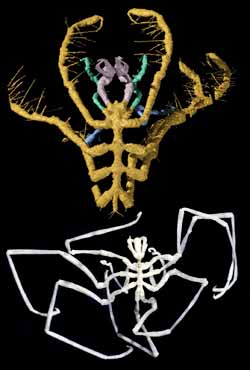Ancient sea spider fossils discovered in volcanic ash

A computer reconstruction of Haliestes (artificially colored, above), and a modern sea spider, Nymphon (bleached, below), which is about 50% larger, and with longer legs.
Volcanic ash that encased and preserved sea life in the Silurian age 425 million years ago near Herefordshire, UK has yielded fossils of an ancient sea spider, or pycnogonid, one of the most unusual types of arthropod in the seas today.
Sea spiders are soft-bodied arthropods, found widely in modern oceans. For two-centuries there has been a controversy about the relationship of sea spiders to land spiders, scorpions, ticks and mites because of their unique body form. Sea spiders have a long proboscis and unusual limb structures used in mating and carrying brooding embryos. The fossil record of their relationship is sparse because of their delicate nature.
“This is the earliest adult fossil example, and it is preserved in extraordinary detail,” said author Derek Briggs, professor of geology and geophysics, and Director of the Yale Institute of Biospheric Studies. “Volcanic ash that trapped ancient sea life in this location rapidly encased the creatures making a concrete-like cast of the bodies. The cavity later filled in with carbonate solids so we have a fossil record to study now.”
To create a picture of the fossils, the specimens were ground away a few microns at a time, each slice digitally imaged, and then the whole reconstructed using computer graphics. The reconstruction suggests that these exotic animals are indeed related to land spiders, scorpions, mites and ticks.
The new species, Haliestes dasos,, represents the earliest known adult sea spider by 35 million years. Its large pincers place the sea spiders firmly within a larger grouping that includes scorpions, mites, ticks, the real spiders and the horseshoe crab. Despite its ancient, Silurian age the new species appears to have lived in a similar way to modern ones, on the seabed, or perhaps on sponges.
The research was carried out as part of a project on the Herefordshire fauna by a team made up of Derek Siveter and Mark Sutton at Oxford, Derek Briggs at Yale, and David Siveter at Leicester. The group has made a number of other spectacular finds of soft-bodied organisms in the same deposit including crustaceans, a worm-like mollusc, a polychaete worm, and a starfish, and much that remains to be described.
Media Contact
More Information:
http://www.yale.eduAll latest news from the category: Life Sciences and Chemistry
Articles and reports from the Life Sciences and chemistry area deal with applied and basic research into modern biology, chemistry and human medicine.
Valuable information can be found on a range of life sciences fields including bacteriology, biochemistry, bionics, bioinformatics, biophysics, biotechnology, genetics, geobotany, human biology, marine biology, microbiology, molecular biology, cellular biology, zoology, bioinorganic chemistry, microchemistry and environmental chemistry.
Newest articles

A 2D device for quantum cooling
EPFL engineers have created a device that can efficiently convert heat into electrical voltage at temperatures lower than that of outer space. The innovation could help overcome a significant obstacle…

Single atoms show their true color
One of the challenges of cramming smarter and more powerful electronics into ever-shrinking devices is developing the tools and techniques to analyze the materials that make them up with increasingly…

Key Cells for Blood Sugar Control Using Optogenetics
How does our body control blood sugar so precisely? An international team led by Prof. Nikolay Ninov at the Center for Regenerative Therapies Dresden (CRTD), part of Dresden University of…





















